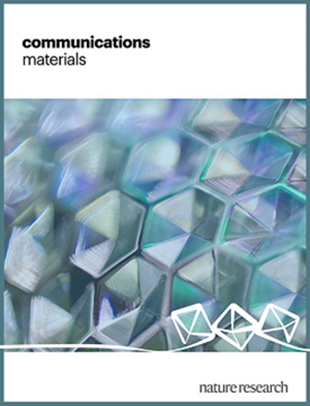A high-temperature multiferroic Tb2(MoO4)3
IF 9.6
Q1 MATERIALS SCIENCE, MULTIDISCIPLINARY
引用次数: 0
Abstract
Magnetoelectric mutual control in multiferroics, which is the electric control of magnetization, or reciprocally the magnetic control of polarization has attracted much attention because of its possible applications to spintronic devices, multi-bit memories, and so on. While the required working temperature for the practical application is much higher than room temperature, which ensures stable functionality at room temperature, the reported working temperatures were at most around room temperature. Here, we demonstrated magnetic control of ferroelectric polarization at 432 K in ferroelectric and ferroelastic Tb2(MoO4)3, in which the polarity of ferroelectric polarization is coupled to the orthorhombic strain below the transition temperature 432 K. The paramagnetic but strongly magnetoelastic Tb3+ magnetic moments enable the magnetic control of ferroelectric and ferroelastic domains; the ferroelectric polarization is controlled depending on whether the magnetic field is applied along [110] or [1 $$\bar{1}$$ 0]. This result may pave a new avenue for designing high-temperature multiferroics. The mutual control of magnetization and polarization in multiferroics is key to spintronic devices, but ensuring its stability at room temperature is essential for practical applications. Here, magnetic control of ferroelectric polarization in Tb2(MoO4)3 is demonstrated up to 432 K, ensuring the stability of magnetoelectric effect well above room temperature.

高温多铁性 Tb2(MoO4)3
多铁性材料中的磁电互控,即磁化的电控制或极化的磁互控,因其在自旋电子器件、多比特存储器等领域的应用前景而备受关注。虽然实际应用所需的工作温度远高于室温,以确保在室温下稳定的功能,但报告的工作温度最多在室温左右。在这里,我们证明了铁电和铁弹性Tb2(MoO4)3在432 K时的铁电极化的磁控制,其中铁电极化的极性与低于432 K转变温度的正交应变耦合。顺磁性但强磁弹性的Tb3+磁矩使铁电畴和铁弹性畴的磁控制成为可能;铁电极化的控制取决于磁场是沿[110]还是沿[1 $$\bar{1}$$ 0]施加。这一结果为高温多铁材料的设计开辟了新的途径。多铁体磁化和极化的相互控制是自旋电子器件的关键,但确保其在室温下的稳定性是实际应用的关键。在432 K的温度下,磁控制Tb2(MoO4)3中的铁电极化,保证了磁电效应在室温以上的稳定性。
本文章由计算机程序翻译,如有差异,请以英文原文为准。
求助全文
约1分钟内获得全文
求助全文
来源期刊

Communications Materials
MATERIALS SCIENCE, MULTIDISCIPLINARY-
CiteScore
12.10
自引率
1.30%
发文量
85
审稿时长
17 weeks
期刊介绍:
Communications Materials, a selective open access journal within Nature Portfolio, is dedicated to publishing top-tier research, reviews, and commentary across all facets of materials science. The journal showcases significant advancements in specialized research areas, encompassing both fundamental and applied studies. Serving as an open access option for materials sciences, Communications Materials applies less stringent criteria for impact and significance compared to Nature-branded journals, including Nature Communications.
 求助内容:
求助内容: 应助结果提醒方式:
应助结果提醒方式:


